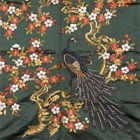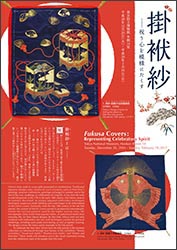Japanese Gallery (Honkan) Room 14
December 20, 2016 (Tue) - February 19, 2017 (Sun)
Fukusa were used to cover gifts presented at celebrations. Traditional Japanese designs were chosen for each occasion, such as New Year’s greetings, seasonal celebrations, greetings exchanged in summer and at the end of the year, weddings, or celebrations for long life. It was from the early to mid- Edo period, in the 17th to the early 18th century, that fukusa came to be ornately decorated. As unique Japanese embroidery techniques developed, auspicious motifs befitting each event began to be embroidered on the fukusa covers. Eventually, from the late 18th century in the late Edo period, the custom of fukusa covers spread to prosperous townspeople. Unlike the stylized patterns used by the higher warrior class, the townspeople chose motifs from popular fables, or patternized motifs from everyday life, for their liberal designs. By this time, fukusa were not only rendered with embroidery but also with techniques suitable for pictorial renderings, including yuzen paste-resist dyeing, as well as tapestry weaving. The designs convey the festive spirits of people in the Edo period.
To celebrate the New Year, fukusa from the Edo period in the museum collection are introduced through four themes in this exhibition: “Stories and fables,” “Good-luck motifs,” “Warrior-class motifs,” and “Deities and festivities.” These motifs will introduce you to the visual expression arising from the celebratory spirit of the people from this time.


